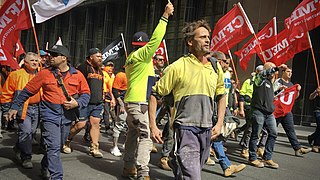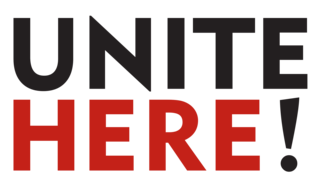
Strike action, also called labor strike, labour strike and industrial action in British English, or simply strike, is a work stoppage caused by the mass refusal of employees to work. A strike usually takes place in response to employee grievances. Strikes became common during the Industrial Revolution, when mass labor became important in factories and mines. As striking became a more common practice, governments were often pushed to act. When government intervention occurred, it was rarely neutral or amicable. Early strikes were often deemed unlawful conspiracies or anti-competitive cartel action and many were subject to massive legal repression by state police, federal military power, and federal courts. Many Western nations legalized striking under certain conditions in the late 19th and early 20th centuries.

The United Farm Workers of America, or more commonly just United Farm Workers (UFW), is a labor union for farmworkers in the United States. It originated from the merger of two workers' rights organizations, the National Farm Workers Association (NFWA) led by César Chávez and Dolores Huerta and the Agricultural Workers Organizing Committee (AWOC) led by organizer Larry Itliong. They allied and transformed from workers' rights organizations into a union as a result of a series of strikes in 1965, when the Filipino American and Mexican American farmworkers of the AWOC in Delano, California, initiated a grape strike, and the NFWA went on strike in support. As a result of the commonality in goals and methods, the NFWA and the AWOC formed the United Farm Workers Organizing Committee on August 22, 1966. This organization was accepted into the AFL–CIO in 1972 and changed its name to the United Farm Workers Union.

The 1936–1937 Flint sit-down strike, also known as the General Motors sit-down strike, or the great GM sit-down strike, was a sitdown strike at the General Motors plant in Flint, Michigan, United States. It changed the United Automobile Workers (UAW) from a collection of isolated local unions on the fringes of the industry into a major labor union, and led to the unionization of the domestic automobile industry.
The United Food and Commercial Workers International Union (UFCW) is a labor union representing approximately 1.3 million workers in the United States and Canada in industries including retail; meatpacking, food processing and manufacturing; hospitality; agriculture; cannabis; chemical trades; security; textile, and health care. UFCW is affiliated with the Canadian Labour Congress (CLC) and the AFL–CIO; it disaffiliated from the AFL–CIO in 2005 but reaffiliated in 2013. UFCW is also affiliated to UNI Global Union and the IUF.

The nature and power of organized labor in the United States is the outcome of historical tensions among counter-acting forces involving workplace rights, wages, working hours, political expression, labor laws, and other working conditions. Organized unions and their umbrella labor federations such as the AFL–CIO and citywide federations have competed, evolved, merged, and split against a backdrop of changing values and priorities, and periodic federal government intervention.

UNITE HERE is a labor union in the United States and Canada with roughly 300,000 active members. The union's members work predominantly in the hotel, food service, laundry, warehouse, and casino gaming industries. The union was formed in 2004 by the merger of Union of Needletrades, Industrial, and Textile Employees (UNITE) and Hotel Employees and Restaurant Employees Union (HERE).

John Francis Shelley was a U.S. politician. He served as the 35th mayor of San Francisco, from 1964 to 1968, the first Democrat elected to the office in 50 years, and the first in an unbroken line of Democratic mayors that lasts to the present. His term in the United States House of Representatives, immediately prior to his mayoralty (1949-1964), also broke a long streak of Republican tenure and began a streak of Democratic representatives from San Francisco that continues to the present.

Union busting is a range of activities undertaken to disrupt or weaken the power of trade unions or their attempts to grow their membership in a workplace.
The following is a timeline of labor history, organizing & conflicts, from the early 1600s to present.

The Great Steel Strike of 1919 was an attempt by the American Federation of Labor to organize the leading company, United States Steel, in the American steel industry. The AFL formed a coalition of 24 unions, all of which had grown rapidly during World War I. In the lead role would be the Amalgamated Association of Iron, Steel and Tin Workers (AA) with a five-member steering committee. The strike began on September 22, 1919, and finally collapsed on January 8, 1920. The opposition led by Elbert H. Gary, president of U.S. Steel had triumphed.

1199: The National Health Care Workers' Union was an American labor union founded as the Drug, Hospital, and Health Care Employees Union-District 1199 by Leon J. Davis for pharmacists in New York City in 1932. The union organized all workers in drug stores on an industrial basis, including pharmacists, clerks, and soda jerks. The union led pioneering pickets and strikes against racial segregation and racially discriminatory hiring in Harlem and elsewhere in New York City during the 1930s.
The Toledo Auto-Lite strike was a strike by a federal labor union of the American Federation of Labor (AFL) against the Electric Auto-Lite company of Toledo, Ohio, from April 12 to June 3, 1934.
The International Seamen's Union (ISU) was an American maritime trade union which operated from 1892 until 1937. In its last few years, the union effectively split into the National Maritime Union and Seafarer's International Union.
The Akron rubber strike of 1936 was a strike by workers against rubber factory owners in Akron, Ohio.
The Martin Luther King, Jr. County Labor Council (MLKCLC) is the central body of labor organizations in King County, Washington. The MLKCLC is affiliated with the national AFL–CIO, the central labor organization in the United States, which represents more than 13 million working people. Over 125 organizations are affiliated with the MLKCLC, and more than 75,000 working men and women belong to Council-affiliated organizations. In addition to supporting labor organizations, it acts as a voice for the interests and needs of the working people in King County, WA.

The International Longshore and Warehouse Union (ILWU) is a labor union which primarily represents dock workers on the West Coast of the United States, Hawaii, and in British Columbia, Canada; on the East Coast, the dominant union is the International Longshoremen's Association. The union was established in 1937 after the 1934 West Coast Waterfront Strike, a three-month-long strike that culminated in a four-day general strike in San Francisco, California, and the Bay Area. It disaffiliated from the AFL–CIO on August 30, 2013.

The Congress of Industrial Organizations (CIO) was a federation of unions that organized workers in industrial unions in the United States and Canada from 1935 to 1955. Originally created in 1935 as a committee within the American Federation of Labor (AFL) by John L. Lewis, a leader of the United Mine Workers (UMW), and called the Committee for Industrial Organization. Its name was changed in 1938 when it broke away from the AFL. It focused on organizing unskilled workers, who had been ignored by most of the AFL unions.
National Dollar Stores, Ltd., formerly known as China Toggery and Sang Lee Dry Goods, was a Chinese American-owned dry goods store chain that operated primarily in the western United States from 1903 to 1996. Founded by Joe Shoong in 1903 and incorporated in 1921, the National Dollar Stores were the first retail chain on the West Coast and one of the largest Chinese American-owned retail chains in U.S. history.
The 1914–1915 Fulton Bag and Cotton Mills strike was a labor strike involving several hundred textile workers from the Fulton Bag and Cotton Mills in Atlanta, Georgia, United States. The strike, which involved about 500 millworkers, began on May 20, 1914, and ended almost a year later on May 15, 1915, in failure for the strikers.
The 1937 Fleischer Studios strike was a labor strike involving workers at Fleischer Studios in New York City. The strike commenced on May 7 of that year and ended on October 12. The strike was the first major labor dispute in the animation industry and resulted in the industry's first union contracts.











